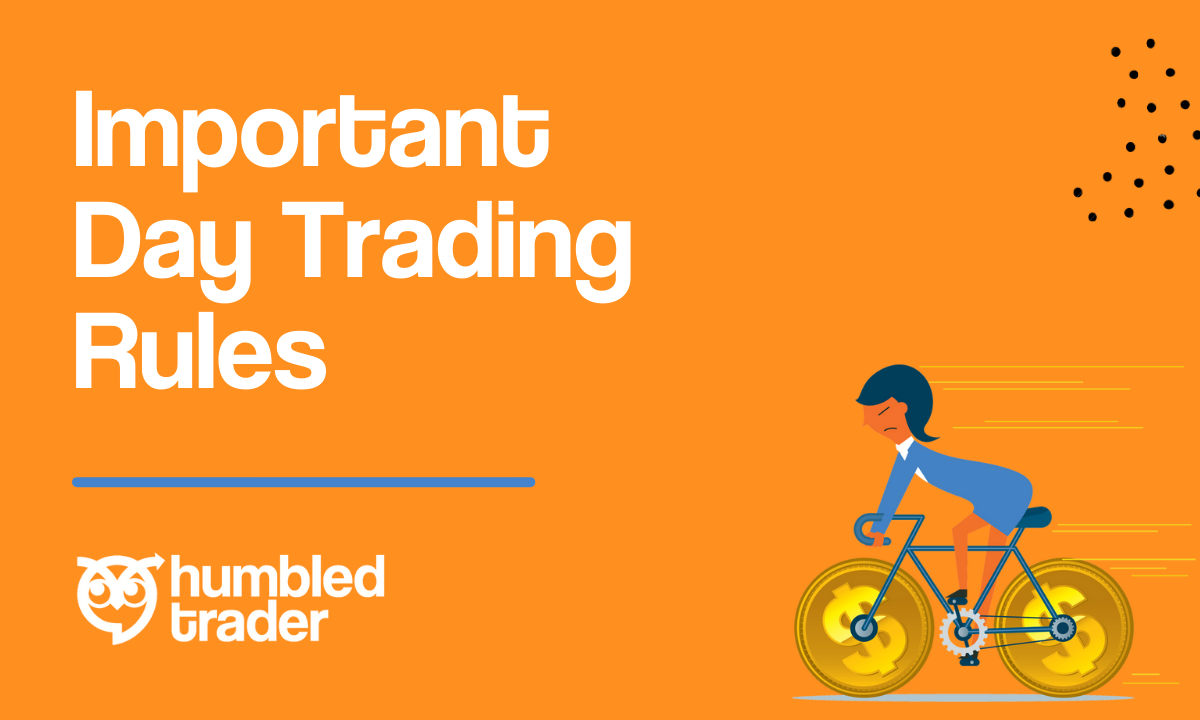Important Day-Trading Rules to Know for 2024

Day trading can be an exhilarating yet challenging endeavor, especially for beginners navigating the volatile financial markets. Success in day trading doesn’t come easy—it requires not just a solid strategy but disciplined risk management and a commitment to learning. In this guide, we’ll break down three essential day trading rules that every trader should follow to boost their chances of long-term success. From managing position sizes effectively to understanding the importance of clean charts with minimal indicators, and adhering to the Pattern Day Trading (PDT) rule, these rules will help you develop a solid foundation. Whether you're new to the world of day trading or looking to refine your approach, mastering these principles can set you apart from the majority of traders who struggle. Let’s dive in!
Day Trading Rule #1: Start Small And Gradually Increase Position Sizes
What is position sizing in trading?
Managing your position sizes carefully is one of the most important day trading rules to follow, especially when you’re just starting out. Position sizing plays a critical role in risk management because it directly impacts how much money you stand to lose in any given trade. For beginners, starting with smaller positions allows them to focus on developing and executing their trading strategies without the added pressure of significant financial exposure. This approach helps new traders avoid large losses while they build consistency, which is key to long-term success.
Why beginner traders should start small?
Starting small helps traders stay disciplined, avoid emotional decisions, and stick to their trading plans. It also encourages good habits like cutting losses quickly, being patient with setups, and resisting the urge to “revenge trade” when they take a loss. Many new traders fall into the trap of rapidly increasing their position sizes after a few successful trades, only to suffer devastating losses when they fail to account for the emotional strain that comes with trading larger sums. Overexposure to a single trade can wipe out weeks or months of gains, which is why managing position sizes and scaling up gradually is essential.
What is the 90% rule in trading?
This is where the "90% rule" comes into play—a well-known principle in trading that states 90% of traders fail. The mistake many make is starting with the mindset that they’ll be part of the 10% from the beginning, without recognizing the risks involved. The 90% rule is not a reason to get discouraged, but rather a reminder to treat trading with serious risk management to avoid becoming part of that majority.
Risk Management Rule
One of the most effective risk management techniques is to set a daily max loss—usually no more than 5% of your account size.
For example, if you have a $5,000 trading account, a good rule of thumb is to limit your maximum loss to $250 per day (5% of $5,000). Now, divide that daily limit across three trades, meaning that you should risk no more than $83 per trade ($250 ÷ 3). This way, even if you lose three trades in one day, you will only lose your daily max of $250, leaving enough capital in your account to continue trading on future days.
Scaling your position sizes gradually
Once you achieve consistent profitability, you can gradually increase your risk per trade as your account size grows. For instance, if your account grows to $10,000, your daily max loss could increase to $500, allowing you to risk about $167 per trade. Scaling your position sizes this way keeps your risk controlled and manageable while letting you compound your account over time.
Day Trading Rule #2: Only Use 1 or 2 Indicators
Keeping your charts clean by using only one or two indicators is crucial for developing a deeper understanding of the market’s core mechanics—buying and selling. By stripping away the clutter of multiple technical indicators, traders can focus on price action and volume, which are the fundamental forces driving market movements. A clean chart helps traders tune into the raw data of price fluctuations, teaching them to interpret market sentiment directly from how buyers and sellers interact. In doing so, traders can develop the essential skill of reading price action, which is often the difference between reacting to lagging indicators and anticipating moves in real time.
Cons of using trading indicators
Over-relying on technical indicators can create problems. Indicators are based on mathematical calculations that require price data to form before they can give signals, meaning they lag behind price action. This delay can result in traders entering positions too late, missing optimal entries, or worse—overtrading in an attempt to catch up. This is particularly dangerous when using multiple indicators on short timeframes, such as the 1-minute chart, where rapid price changes can generate conflicting signals, leading to fear-of-missing-out (FOMO) and emotional trading.
What is the best trading indicator?
One powerful indicator to consider when paired with price action is the VWAP (Volume Weighted Average Price). VWAP calculates the average price of a stock, weighted by volume, over a specific period. It’s often used as a gauge for institutional activity and can help identify whether market sentiment is bullish or bearish. When a stock’s price is trading above the VWAP, it suggests more bullish sentiment, while trading below it indicates a bearish bias. However, even VWAP is most effective when viewed through the lens of price action.
What are the golden rules of day trading?
The three golden rules of trading that emerge from this rule are: Price action is king, and not indicators.
Indicators are useful for beginners, but as traders gain experience, they should shift towards focusing on price action.
Finally, understanding volume is the best indicator, as it reveals the strength behind price movements and helps traders confirm the validity of trends.
Day Trading Rule #3: Beginners Should Stick to the Pattern Day Trading Rules (PDT)
What is the PDT rule?
The Pattern Day Trading (PDT) rule is a regulation set by the Financial Industry Regulatory Authority (FINRA) in the U.S., which requires traders who execute more than three day trades within five business days to maintain a minimum account balance of $25,000. This rule applies to margin accounts and is designed to protect traders from excessive risk.
How does the PDT rule affect traders?
For those who fall under the PDT designation, the rule limits the number of trades they can make within a week, which can significantly impact their trading strategies. While this limitation may feel restrictive—especially when market conditions offer several profitable opportunities—it serves an essential purpose.
For beginner traders, the PDT rule can act as a safeguard, helping them avoid the emotional pitfalls of overtrading. Overtrading often stems from a psychological desire to chase profits or recover losses, which can lead to reckless decision-making and significant losses. By limiting the number of trades, the PDT rule encourages traders to be more selective and strategic about their entries and exits, thereby fostering discipline. Though seasoned traders might find the rule cumbersome, for newer traders, it offers a structured way to build good habits, focus on high-quality setups, and protect their capital as they develop their skills.
Conclusion
Day trading is as much about managing risk and psychology as it is about making profitable trades. By sticking to the fundamental rules—gradually increasing position sizes, keeping your charts clean with only 1 or 2 indicators, and adhering to the Pattern Day Trading (PDT) rule—traders can build a disciplined and strategic approach. These rules not only protect you from overexposure and emotional trading but also guide you toward developing the skills and mindset necessary for long-term success. Remember, trading is a marathon, not a sprint. By focusing on consistency and following these guidelines, you’ll be setting yourself up for sustained growth in your trading journey.
Ready to take trading seriously? Join the Humbled Trader Community and learn to trade with real traders.
Trade with Humbled Trader CommunityOther Day Trading Rules Examples
What is the 3-5-7 Rule in Trading?
The 3-5-7 rule is a guideline for managing risk in day trading. It suggests limiting yourself to no more than 3 trades per day, risking no more than 5% of your total account on a single trade, and aiming for at least a 7% profit target per trade. This rule helps traders avoid overtrading, manage their risk, and set reasonable profit expectations. It promotes discipline and helps traders focus on high-quality setups instead of impulsive decisions.
What is the 10 AM Rule in Stock Trading?
The 10 AM rule suggests waiting until 10 AM ET to enter trades. In the first 30 minutes of market opening, prices tend to be volatile due to overnight news, economic reports, or emotional retail trading. By waiting until after 10 AM, traders allow the market to settle into more stable price movements, making it easier to gauge the day’s true direction. This rule is especially useful for day traders looking to avoid the initial whipsaws of the market’s open.
Don’t feel like reading? Watch the video.




